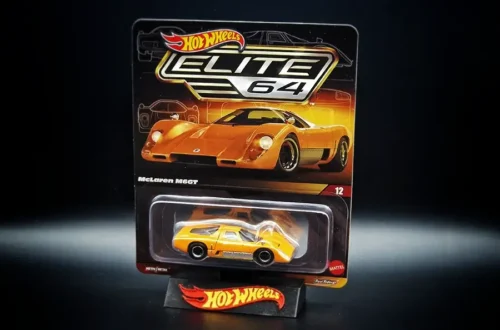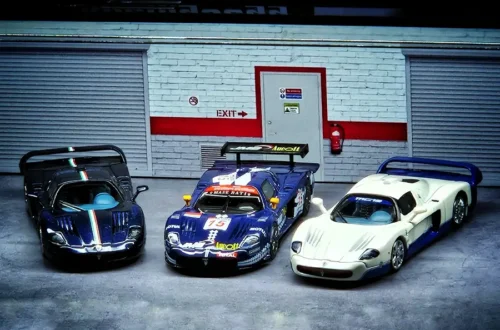
The RISE AND FALL of the DTM – MiniGT, Tarmacworks, Hot Wheels FEATURETTE
How it all began
The DTM was already known as the DRM, the German Racing Championship, in 1972 and enjoyed enormous popularity. Originally, production-based Group 2 touring cars competed in the racing series before the FIA adapted the regulations in 1982 and paved the way for Group C sports cars. The BMW 3.5 CSL and the M1, which was used in the Pro Car Series as well as in rallying, were famous names at the time, especially from BMW's point of view. Hot Wheels provided us with numerous colour variants of the 3.0 CSL from 1973 and the M1 Pro Car. This concept of the DRM was associated with enormous costs, which is why a new concept had to be invented.

New set of rules for 1984
A new set of rules for low-cost, production-based touring cars was presented for 1984. In 1984 and 1985, the DTM was first set up as the DPM, the "German Production Car Championship". Not only German manufacturers like Opel and BMW took part, but also Ford, Alfa Romeo and Chevrolet. Appropriate models from this time are the Alfa Romeo GTV6 from Hot Wheels and the Z28 Camaro, also from Hot Wheels. In the following years, the interest of the public and the media in the DTM increased continuously. The only thing the racing series lacked was a clear line after the concept changed to a works championship between the manufacturers Audi, Alfa Romeo, BMW, Mercedes-Benz, Ford and Opel.

Total chaos 1985 to 1989
What originally started as an event for private tuners was associated with ever increasing costs over the years, which ultimately led to a withdrawal of the private investors. At the same time, it had to be ensured that the different racing cars were also on the same level on the track, which turned out to be a tricky balancing act. Turbo engines, naturally aspirated engines and a corresponding alignment with additional weights or air volume limiters not only caused confusion but also added to the vulnerability of the cars. The best case study is the legendary Ford Sierra RS 500 Cosworth from 1986 to 1989 and at that time, with its almost 550 hp, it was the measure of all things in worldwide touring car racing! And this despite the fact that the vehicle was only allowed to produce just under 380 hp in DTM mode.
A prime example in the model car circus is the 1987 model in Texaco design by Inno64. The end of turbo engines led to Ford's withdrawal from the racing series as the dominant force, but the arms race continued. In 1990, all manufacturers tried their hand at their own concept of the so-called "classless society", but there was simply to be no uniform solution.

Audi dominance in 1990 and 1991
In the 1990 season, for example, Audi competed with 3.6-litre V8 engines including four-wheel drive, while BMW and Mercedes relied on 2.5-litre naturally aspirated engines with only four cylinders. Due to their superiority, especially on high-speed tracks, Audi secured two championship titles in a row with Hans-Joachim "Strietzel" Stuck in 1990 and Frank Biela in 1991, before DTM legend Klaus Ludwig was to put an end to Audi's dominance one year later. After Audi had been scandalously banned from a newly designed crankshaft, the manufacturer left the DTM midway through the 1992 season - the concept of a classless society was deemed to have failed and new regulations were needed. Unfortunately, there are no 1:64 scale models of the Audi V8 DTM from 1990 and 1991, so there is still a lot of catching up to do in the model car segment. MiniGT published numerous versions of the Mercedes-Benz 190E 2.5-16 Evo II from 1990 to 1991 driven by Ludwig, Lohr, Asch and Schumacher. By the way, all models are shown in the cover picture of this article.
The heyday of the DTM 1992 - 1996
In 1992, Mercedes paved the way for the very first DTM title win with Klaus Ludwig's 190E 2.5-16 Evo II. MiniGT, like Tarmacworks, contributed the matching 1992 model of Keke Rosberg. From then on, from the 1993 season onwards, the DTM relied on the "Class 1 regulations", which, however, could be interpreted very freely by the manufacturers Alfa Romeo, Audi, BMW, Mercedes-Benz and Opel. It allowed touring car prototypes that did not necessarily have to have much in common with production-based vehicles.

The 1993 DTM year was to be dominated by newcomer Alfa Romeo, who were to set themselves apart from the competition with the legendary Alfa Romeo 155 V6 TI of the Alfa Corse team and in the form of the champion Nicola Larini. Opel also returned to the DTM for the season finale with the Calibra V6 4x4. Former Formula 1 World Champion Keke Rosberg secured the first championship points for the car manufacturer on its debut weekend. Minichamps offers matching models of both the 155 V6 TI and the Opel Calibra with extreme attention to detail. The 155 V6 TI models from Hot Wheels are a little more relaxed and simpler, and although they are much easier to get hold of, they lack the attention to detail.

C-Class dominance and the end in 1996
In the following years, the arms race in the DTM would once again overshadow the racing series. Klaus Ludwig (1994) and Bernd Schneider (1995) led the Mercedes-Benz brand to victory in the championship, but apart from the manufacturer from Stuttgart, only Alfa Romeo and Opel were still active in the series. only Alfa Romeo and Opel were still active in the series due to the immensely increased costs. Hot Wheels contributed the matching C-Class models with the silver and yellow Premium models.
The 1996 ITC season is still considered the most technically advanced touring car championship of all time and offered even more freedom in terms of rules than Formula 1 did at the time. However, as the costs exploded once again in the course of the season and the entry fees were not affordable, Alfa Romeo and Opel withdrew from the ITC at the end of the 1996 season, thus sealing the end of the racing series.

DTM-Revival 2000
After a few years' break, the DTM returned in 2000 under the name German Touring Car Masters. With new, spectacular cars, lower costs and additional races abroad, the touring car racing series should have finally found its line and started its triumphal procession. Suitable models for this are, for example, the Mercedes-Benz CLK AMG DTM models 2002 and 2003 by Kyosho. However, peace was still not to return to the DTM. After Opel pulled out again in the 2005 season, BMW returned to the racing series for the 2012 championship as a third manufacturer alongside Mercedes-Benz and Audi. For the 2019 season, Aston Martin replaced the Mercedes-Benz cars with the Vantage DTM, but withdrew again the following year. The DTM was once again in danger of falling into chaos, which is why there was a far-reaching restructuring for the 2021 season.

DTM GT3 from 2021
From the 2021 DTM season onwards, the touring car championship started with GT3 cars, which opened the way for additional brand diversity. With racing cars from Ferrari, Lamborghini, Mercedes, BMW, McLaren, Porsche and Audi, the DTM in 2021 would present itself as diverse and international as never before. Red Bull also made a DTM comeback together with AF Corse. Tarmacworks, for example, published the two Ferrari 488 GT3 models for the 2021 season of Liam Lawson and Alexander Albon, each with F1 past and F1 future respectively. MiniGT, in turn, contributed the model car of the 2022 DTM champion, Sheldon Van der Linde's BMW M4 GT3.

What do you think about the history of the DTM? What was your favourite era? Let us know in the comments!
We got some RACE CARS FOR SALE at Doramas.ch - Be sure to check them out!


You May Also Like

Koenigsegg Gemera -The most powerful production car in the world – FEATURETTE
July 22, 2023
Hot Wheels Elite64 McLaren M6 GT – The forgotten legend FEATURETTE
March 2, 2025
